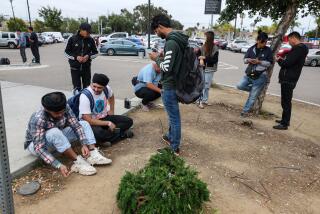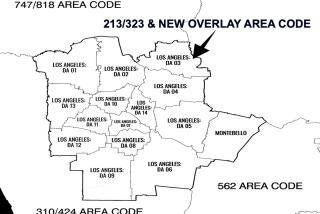805 Reasons and More Not to Divide Area Code
- Share via
You’ve seen the headlines: “Officials Press for County to Retain 805 Area Code,” and “Fight With Other Counties for 805 Heats Up.” The Central Coast has been presented with a Hobson’s choice: We are being told that the 805 area code must be split into two. This is clearly not desirable, and Ventura County finds itself in a war of words with neighbors to the north. We are making the argument that we should retain the 805 area code; they contend just as vehemently that it should be theirs.
Before arguing about details of the 805 relief plan, we first need to understand that it is the worst-case scenario--i.e., that the 805 runs out of numbers. Current regulations required this relief process to begin, hence the recent hearings and headlines. But regulations are also what got us into the predicament. If we instead focus on these regulations and new legislative efforts in this policy area, I believe we will find a solution that will keep area code relations on the Central Coast friendly.
First, a little background. From 1947 until January 1997, the number of area codes in California increased gradually from three to 13. During the subsequent three years, the number nearly doubled, to 25 by the end of 1999. At this pace, California is projected to have 41 by the end of 2002.
On the Central Coast, you will recall, the 805 was split east-west in 1999, placing Kern County and other inland areas under the 661 area code. Barely nine months later, in September 1999, it was reported that relief would again be needed within 30 months because the 805 was projected to run out of available prefix codes during the third quarter of 2002. This number exhaustion was due, in part, to an increase in the local phone service market competition and growing demand for telephone numbers. In fact, however, no number shortage exists in the 805 area code.
*
For instance, a major contributing factor to 805 number exhaustion is a technical regulatory requirement in the phone network that allocates numbers in blocks of 10,000. This is a holdover from days when only one carrier was authorized to provide service to customers in a specific territory. Today in the 805, we have 43 telephone carriers. Yet each of these obtains numbers in blocks of 10,000, whether they have 15 or 8,790 customers. Thus, the allocation of numbers in blocks of 10,000 is creating an artificial demand for numbers, which in turn creates the need for more area codes.
In September 1999, when the demise of the 805 as we know it was predicted, the Federal Communications Commission granted the California Public Utilities Commission permission to issue new numbers to telephone companies in blocks of 1,000 instead of 10,000. Called number pooling, the process lets several carriers share the resources of the previous 10,000-number block.
Further, the CPUC can now force carriers, such as the 43 in the 805 area, to disclose how many numbers are actually in use and release the others so they can be assigned to other carriers.
The CPUC also ordered a number utilization study for the 805 and all other area codes facing number exhaustion. The data for the 805 will be available Oct. 1.
But the question arises: How can we be sure that we will find the numbers we need?
We need only look at the 310 area code, which has been ground zero for area code relief. On March 16, the CPUC released the startling results of a number use study that found that 3 million unused numbers exist in the 310 area code.
I believe a similar finding will be made in the 805 when the study data are released in October.
*
Therefore, I urge you to write to the CPUC and ask it to do what is in the best interest of customers. It is time to unite behind the CPUC’s efforts to conserve numbers, including pooling and more efficient use practices such as requiring that numbers be assigned sequentially and that carriers meet minimum usage rates before they may obtain additional numbers.
I also ask you to support Senate Bill 1741, authored by state Sen. Debra Bowen (D-Marina del Rey) and co-authored by me. This bill proposes a new paradigm for area codes by putting all those gizmos gobbling up phone numbers--like automatic teller machines, store terminals for credit and debit cards, and data lines at work--into a technology-specific area code.
It is time to derail the 805 area code relief process. We clearly have other, more viable options.
More to Read
Sign up for Essential California
The most important California stories and recommendations in your inbox every morning.
You may occasionally receive promotional content from the Los Angeles Times.










